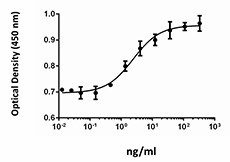- Regulatory Status
- RUO
- Other Names
- Fibroblast Growth Factor-10, FGF10, Keratinocyte growth factor 2, KGF-2

-

MCF-7 cell proliferation induced by human FGF-10 in the presence of 2 µg/mL heparin. -

Human FGF-10 induces MCF-7 cell proliferation in the presence of 2 μg/mL of heparin, in a dose-dependent manner. BioLegend’s human FGF-10 product was compared side-by-side to a competitor’s equivalent product.
| Cat # | Size | Price | Quantity Check Availability | ||
|---|---|---|---|---|---|
| 559302 | 10 µg | $124.00 | |||
| 559304 | 25 µg | $223.00 | |||
| 559306 | 100 µg | $686.00 | |||
| 559308 | 500 µg | $1987.00 | |||
FGF-10 is a member of the fibroblast growth factor family and also belongs to the FGF-7 subfamily. The mitogenic activity of FGF-10 is similar to that of FGF-7. It has no mitogenic activity for NIH/3T3 cells. FGF-10 acts as a paracrine growth factor and plays multiple roles in organogenesis. FGF-10 is essential for embryonic lung branching morphogenesis. During embryonic lung development, FGF-10 is expressed in the distal mesenchyme and acts on the distal lung epithelial progenitors to prevent them from differentiating into proximal epithelial cells by inducing Sox9 and repressing Sox2 expression. FGF-10 knockout mice die at birth due to lack of lung and limb formation. FGF-10 takes an important role in adult lung repair and its regulation is critical for the amplification of epithelial progenitors. FGF-10 also controls adipocyte differentiation by inhibiting C/EBPβ. The development of embryonic white adipocyte tissue of FGF-10 knockout mice is greatly impaired. In addition, FGF-10 participates in the development of pancreas, stomach, skin, hair follicle, as well as wound healing. Increased expression of FGF-10 and the receptor FGFR2-IIIb are associated with several diseases such as prostate, breast, pancreas, and colorectal cancer, which suggests a role of FGF-10 in carcinogenesis.
Product Details
- Source
- Human FGF-10, amino acids (Leu40-Ser208) (Accession# BC105021), was expressed with a N-terminal Met tag in E.coli.
- Molecular Mass
- The 170 amino acid recombinant protein has a predicted molecular mass of approximately 19.2 kD. The protein migrates at approximately 25 kD in DTT-reducing and non-reducing conditions by SDS-PAGE. The predicted N-terminal amino acid is Met.
- Purity
- >95%, as determined by Coomassie stained SDS-PAGE.
- Formulation
- 20 mM Tris, pH 7.0, 100 mM NaCl, 1 mM EDTA, and 10% glycerol.
- Endotoxin Level
- Less than 0.01 ng per µg cytokine as determined by the LAL method.
- Concentration
- 10 and 25 µg sizes are bottled at 200 µg/mL. 100 µg size and larger sizes are lot-specific and bottled at the concentration indicated on the vial. To obtain lot-specific concentration and expiration, please enter the lot number in our Certificate of Analysis online tool.
- Storage & Handling
- Unopened vial can be stored between 2°C and 8°C for up to 2 weeks, at -20°C for up to six months, or at -70°C or colder until the expiration date. For maximum results, quick spin vial prior to opening. The protein can be aliquoted and stored at -20°C or colder. Stock solutions can also be prepared at 50 - 100 µg/mL in appropriate sterile buffer, carrier protein such as 0.2 - 1% BSA or HSA can be added when preparing the stock solution. Aliquots can be stored between 2°C and 8°C for up to one week and stored at -20°C or colder for up to 3 months. Avoid repeated freeze/thaw cycles.
- Activity
- The ED50 is 2 - 10 ng/mL, corresponding to a specific activity 1.0 - 5.0 x 105 units/mg, as determined by a dose-dependent stimulation of MCF-7 in the presence of 2 µg/mL heparin.
- Application
-
Bioassay
- Application Notes
-
BioLegend carrier-free recombinant proteins provided in liquid format are shipped on blue-ice. Our comparison testing data indicates that when handled and stored as recommended, the liquid format has equal or better stability and shelf-life compared to commercially available lyophilized proteins after reconstitution. Our liquid proteins are verified in-house to maintain activity after shipping on blue ice and are backed by our 100% satisfaction guarantee. If you have any concerns, contact us at tech@biolegend.com.
- Product Citations
-
Antigen Details
- Structure
- Growth factor.
- Distribution
-
FGF-10 is expressed and secreted by the mesenchyme fibroblasts during embryonic development. It is also secreted by 3T3L1 preadipocytes.
- Function
- FGF-10 is an epithelial-mesenchymal signaling molecule and plays an important role in multi-organ development. Its expression is regulated by Wnt signaling, Pax9, and cMyc.
- Interaction
- FGF-10 targets urothelial cells, epithelial cells, epidermal cells, keratinocytes, and smooth muscle cells. FGF-10 interacts with FGFBP1.
- Ligand/Receptor
- FGFR2-IIIb.
- Cell Type
- Embryonic Stem Cells, Hematopoietic stem and progenitors, Mesenchymal Stem Cells, Neural Stem Cells
- Biology Area
- Cell Biology, Neuroscience, Stem Cells, Synaptic Biology
- Molecular Family
- Cytokines/Chemokines, Growth Factors
- Antigen References
-
1. Sekine K, et al. 1999. Nat. Genet. 21:138.
2. Petiot A, et al. 2003. Development 130:5493.
3. Tagashira S, et al. 1997. Gene 197:399.
4. El Agha E and Bellusci S. 2014. Scientifica 2014:538379.
5. Ramasamy SK, et al. 2007. Dev. Biol. 307:237.
6. Yamasaki M, et al. 1999. Biochem. Biophys. Res. Commun. 258:109.
7. Emoto H, et al. 1997. J. Biol. Chem. 272:23191. - Gene ID
- 2255 View all products for this Gene ID
- UniProt
- View information about FGF-10 on UniProt.org
